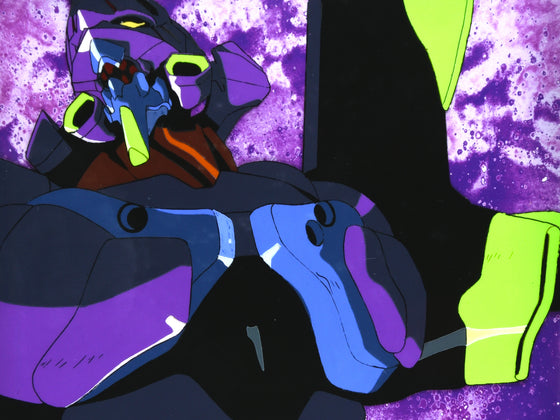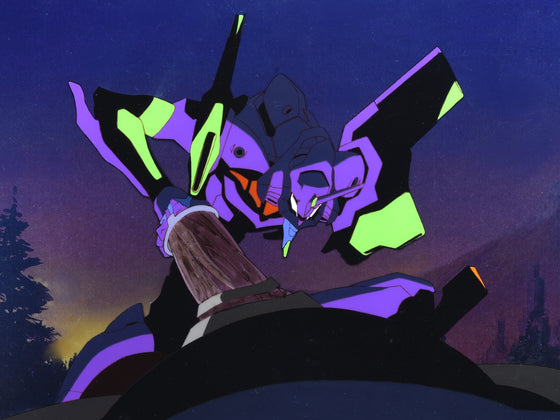Here it is, an iconic close-up cel of Ayanami Rei with a smile from the famous "Smiling would be a good start." scene, in not the original 1995 TV broadcast but the even more incredible
Death and Rebirth movie version! Without a doubt one of the most valuable as well as beautiful cels in the history of animation, as it still holds the place of 3rd most expensive cel ever to be sold in Japan (first and second being Ghibli movie cels both much larger than this standard size), with a hammer price of 9,100,000 yen ($68,000 US with the exchange rate at that time) not including the 10% auction premium and other fees on Mandarake in May 2023.
Truth be told, Sadamoto Yoshiyuki, the famed character designer behind Evangelion who also illustrated the manga version that began a few months earlier than the anime, was very unhappy with this scene in the original TV version both personally and professionally, as Ayanami "just smiled too much" and vowed to redeem the scene in the later movie version, as seen here. Although the awkward but genuine smile in the original version was great in its own way, the improvement here is quite significant as the new rendition is almost identical to the incredible manga version drawn by Sadamoto that was published only a few months earlier. It is also the only scene that was animated by Sadamoto himself in the entire show including all TV episodes and movies, as evidenced by Sadamoto being credited as the "animation director" in Death. With an exception of being credited as "layout support" in Rebirth, this remains the only time Sadamoto was credited as anything other than character designer.
However, the astonishing quality and close involvement by the renowned creator aren't the only reasons why this cel is so desirable, especially to anime fans who watched Evangelion as it aired for the first time in Japan in 1995. Despite (or maybe even helped by) the incomplete ending, the original TV broadcast of Evangelion immediately sensationalized the anime fans across Japan as soon as it premiered and the fans remained even more enthusiastic after it ended, with the media calling the sheer number of and excitement among fans as "Eva Mania" (or dubbed "Eva Shock" in Japanese), while the creators promised a satisfying conclusion to the story in the upcoming movie scheduled to be premiered in March 1997 which only added more fuel to the fire. Interestingly, the movie that was supposed to premier in place of End of Evangelion in July 1997 was a completely new adaptation of Evangelion that strongly resembles Attack on Titans with Angels attacking and devouring humans unlike the original version. But the production of Evangelion remained hectic, stressful, and behind the schedule as ever, partially due to Anno's work ethic that produced almost 3 hours of storyboard for the Rebirth/End of Evangelion instead of the allotted 60 minutes which led to the animation process being significantly delayed, as well as his declining mental health at the time. The gist of the story can be read in the English Wikipedia entry of the End of Evangelion which led to the famous February 14, 1997 press release and an official apology for not meeting the schedule and postponing the ending.
While it was not the complete ending to the story that was promised, the anticipation of fans prior to the March 1997 movie premiere to see the new part could not have been more intense, as well as criticism of it not containing the promised ending. Unlike anime fans now or in the mid-2000's and later when Evangelion was first dubbed and introduced outside Japan in full, anime fans in Japan during the 90's had no choice but to catch the original broadcast at a certain time in front of a television every week to watch a particular show they wanted, or pay money to rent a video which not only required you to own a VHS deck to play, but contained only two episode per volume and only the first 20 episodes were available until 1998... As opposed to being able to watch all of the episodes and movies at once, and because of this many fans outside Japan did not even watch the Death and Rebirth and only the End of Evangelion which contained all of the new parts the TV version did not. This also offers some explanation as to why Rei cels in general tend to be much more valuable especially in Japan, compared to other characters including Asuka. When the "Smiling would be a good start" scene aired for the first time, which is consistently voted in Japan to be one of the best and most important scenes in all of anime history, Asuka was not even introduced to the plot yet.
But in regard to this cel, it is safe to say that nearly all of the fans who saw Death and Rebirth in the theater did so after watching Evangelion only once, months ago for the first time on TV and one episode at a time each week, with this particular image of Rei burned into their memories much stronger than the original TV version. There were actual articles written in anime enthusiast magazines at the time about how beautifully done this cut was, and how it made the audiences in the theater audibly hold their breaths in astonishment. While it is without a doubt impossible to achieve this level of detail and animation quality consistently for a full TV episode, let alone a feature-length movie, Sadamoto certainly accomplished what he has set out to do with this scene. With Evangelion being considered globally to be one of the greatest animated series of all time, transcending genres and borders while being a quintessential Japanese giant robot anime produced for television, this cel is a true holy grail and one of the most collectible animation art of all time!











